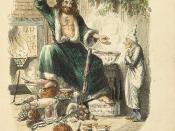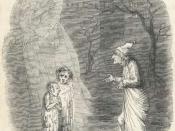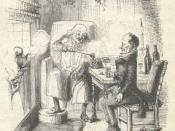A 'Christmas Carol' was written in 1843 by Charles Dickens, to portray perhaps his own beliefs- as social critic- about how the world was at the time, set in the dingy London town.
In the eyes of his selfish vindictive protagonist, Ebenezer Scrooge, the poor were vermin to be steered clear of and money was his everything, suggesting the attitude of the upper class citizens at the time. The shocking truth of the venomous creature Scrooge would become of in the years to come, haunted him into a better person. Forcing him out of the dark and seeing the light. The dark depth and cruel times for the poor, dickens wrote this novella in, opened many eyes to realise this was not the way to live.
"Merry Christmas! What right have you to be merry? What reason have you to be merry? You're poor enough." To begin with, in Stave 1, Scrooge's personality reflects the general hate for the lower class, even if they are family.
In the very first paragraph, Dickens really emphasizes the fact that Scrooge's only friend- Marley was dead. Repetition plays a major role as the continuous echo of "Marley was dead"- the very first words-implies he clearly meant the world to Scrooge. However definite and final death is, Dickens writes "to begin with" and "there is no doubt". It implies perhaps that there is doubt; maybe in Scrooge's mind, that Marley could still be alive, because an event such as death should not have to be written with any 'doubt'. This proves that Scrooge is unstable.
Ebenezer Scrooge is described as Marley's "sole executor, his sole administrator, his sole assign, his sole residuary legatee, his sole friend and his sole mourner." Dickens accentuates 'sole' as if Scrooge was now alone in the world. From...


